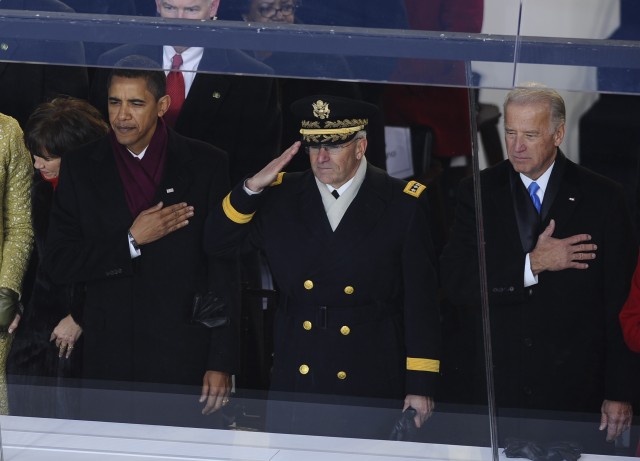
WASHINGTON (Army News Service, Jan. 26, 2009) -- About 17,500 servicemembers supported the inauguration of President Barack Obama Jan. 20, including Soldiers who served in key ceremonial positions, marched in the parade and provided security augmentation.
Some of the Soldiers had been working with the Armed Forces Inaugural Committee for almost a year to plan events which began with a concert on Sunday, included the oath at the Capitol Tuesday and ran late into the night with 10 inaugural balls. AFIC provided communications and transportation support and helped coordinate all of the events.
Army Chief of Staff Gen. George Casey Jr. arrived at AFIC headquarters early in the morning on inauguration day to visit with Soldiers supporting the ceremonies and parade. Later in the day he watched all the Army units march by as he sat in the parade reviewing stand near the White House. He sat next to President Barack Obama and First Lady Michelle Obama.
Army Reserve Sgt. 1st Class Greg Ramsdell supervised Soldiers who provided escort duties for parade participants. "The contribution is enormous," Ramsdell said.
More than and 300 busloads of marchers assembled for the parade, which also included about 200 horses.
It was 20 degrees and windy outside the Pentagon when parade participants gathered before dawn on Tuesday.
"Bone-chilling," said Spc. Angela Harper of the District of Columbia National Guard's 276th Military Police Company as she shivered. But she said she wouldnAca,!a,,ct want to be anywhere else.
"This is a wonderful moment in time, and I'm privileged to have this opportunity," Harper said. "I would do it again, and again, and again."
The 504th Parachute Infantry Regiment, 82nd Airborne Division, brought about 100 Soldiers from Fort Bragg, N.C., to march in the parade.
"The opportunity we have to participate in this transfer of government is exciting to myself and my paratroopers," said Lt. Col. Xavier Brunson, 1st Battalion, 504th Parachute Infantry Regiment.
Master Sgt. Jeff Lopez, a clarinetist with the U.S. Army Field Band that led the parade, was focused on the meaning of the day for the armed forces.
"It represents a military change of command," Lopez said. "As a military change of command ceremony would happen on a post, so that's what we're doing today -- and we're changing our commander in chief."
Sgt. 1st Class Mark Stallworth of the Army Reserve said he would never forget marching.
"I can tell my son," Stallworth said. "My grandchildren. Great-grands. This is something that you can always say that you were a part of, pass it down the line. Call home to your mother and father, 'Hey, mom, look at me!' "
Almost 10,000 National Guard troops supported the inauguration, including those who were on standby to provide emergency services if things went wrong. It was the largest National Guard contribution to a presidential inauguration since Minutemen gathered for the First Muster in Massachusetts more than 372 years ago.
National Guard members from a dozen different states and the District of Columbia provided communications, transportation, traffic control and medical and logistical support to civilian authorities staging the inauguration.
Active-duty Soldiers from the Army's 911th U.S. Army Technical Rescue Engineer Company out of Fort Belvoir, Va., were poised to help first responders rescue those trapped in collapsed building should such an incident occur during inaugural activities.
"If a building were to fall down, we'd go in to shore it up and basically stabilize the building," said Sgt. Robert Huffman, 911th EC. "If the air is bad we're going to go in on air, if not just with respirators -- whatever we need to do to extricate the people. It's very similar to what firemen do."
Huffman, who's been in the Army going on four years now, says the 911th EC uses tools like concrete saws, wood chainsaws, torches, exothermic torches, breathing apparatus, shoring equipment and trenching equipment to conduct their rescues.
The 911th EC trains with state, local and federal agencies, to include the Federal Emergency Management Agency Urban Search and Rescue Teams, to develop and maintain the most advanced skills in the field.
Sgt. Malkia Litaker, with the 947th Military Police Detachment at Fort Myer, Va., was one of many Army military working dog handlers who were asked to augment security during inaugural activities.
Litaker and her military working dog, Gerko, work together to seek out potential explosives. She said Gerko can detect up to nine different chemical scents that might indicate the presence of explosives.
"We make sure everything is safe for all the people in the area and the president," she said. "
Maj. Gen. Richard J. Rowe Jr., commander of both Joint Force Headquarters - National Capitol Region and the Army's Military District of Washington, also commanded the Armed Forces Inaugural Committee.
Rowe said the 7,500 servicemembers in JFHQ-NCR had three roles during the inauguration, including providing ceremonial support, providing specific DOD capabilities to federal agencies in charge of inaugural events, and were also prepared for a consequence-management requirement should anything go wrong.

Social Sharing